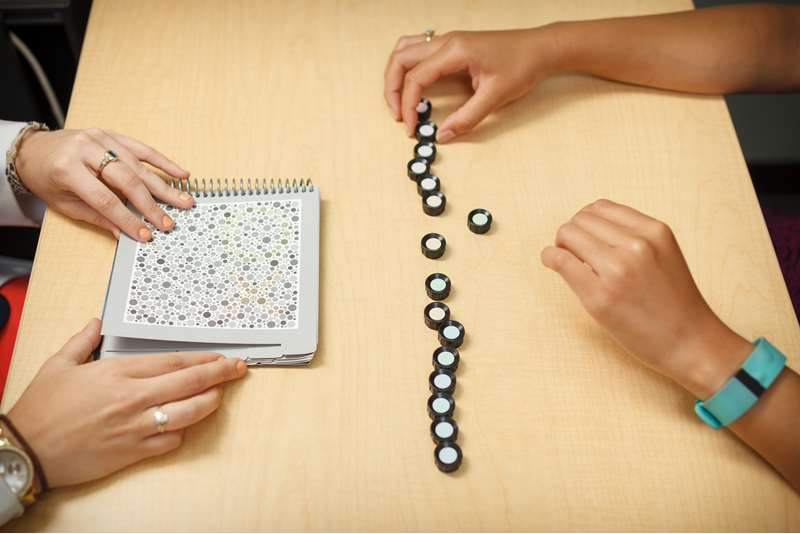Color Vision Research in the MCW AOIP
Dr. Carroll and the AOIP have a long history of research into human color vision (see our Research Publications for examples). All of our research on color vision is supported by grants from the National Eye Institute. In particular, we are interested in studying cases of abnormal color vision – clinically referred to as “color vision defects”. The severity of these color vision defects varies depending on the genetic cause. For example, patients with achromatopsia have a complete absence of color discrimination, caused by mutations in genes that allow the cone cells in the retina signal the presence/absence of light. About 1 in 30,000 people have achromatopsia, with males and females being equally likely to be affected. We are involved in number of clinical trials aimed at evaluating the natural history of achromatopsia as well as Phase I/II trials exploring gene therapy approaches for restoring cone function to these patients.
Another severe color vision defect is blue-cone monochromacy (BCM). Normal color vision relies on having three distinct types of cone in the retina – long-, middle-, and short-wavelength sensitive (also called red-, green, and blue-). Patients with BCM have mutations in the genes that encode the photopigments found in the red and green cones, rendering them non-functional. This means that their color vision is based entirely on one cone type (hence the term “monochromacy”). Moreover, the blue cones normally comprise only about 5-10% of the total number of cone cells in the human retina, so patients with BCM also have severely reduced visual acuity, since it is the cone cells that support our high visual acuity. The genes that encode the photopigments found in the red and green cones are on the X-chromosome, meaning BCM is nearly exclusively found in males, with an incidence of about 1 in 100,000.We are proud to partner with BCM Families Foundation in our research efforts on this condition.
We also study more common forms of color vision defects. Disruptions in only one of the genes that encode the photopigments found in the red and green cones results in a milder color vision defect called “red-green color vision deficiency." Like BCM, this is an X-linked condition, but it is much more common, affecting 8-10% of men. Depending on the exact genetic mutation, some of these patients can have high refractive error (myopia or nearsightedness). We were part of a team that discovered that some of these mutations can also result in disruptions in retinal structure, even the degeneration of some of the cone cells in the retina. This was only possible through the use of our advanced adaptive optics imaging systems.
There are additional color vision defects that can arise later in life due to other conditions, such as glaucoma or diabetes, as well as from certain drugs such as hydroxychloroquine toxicity. We support the clinical color vision testing services offered by our eye care providers in the Eye Institute.
Within the AOIP are two dedicated color vision testing suites with specialized lighting to ensure testing accuracy. These spaces house a variety of color vision tests including: C100, FM100, Farnsworth Panel 15, Lanthony Desaturated D15, Nagel Anomaloscope, Colour Assessment and Diagnosis (CAD) color vision test, and pseudoisochromatic plates (AO-HRR, Richmond HRR 2004 edition, Dvorine, and Ishihara).

Shown above are the Lanthony Desaturated D15 and the Ishihara pseudoisochromatic plates.
We also collaborate with Drs. Jay and Maureen Neitz at the University of Washington. The Neitz Lab are leaders in the genetic basis of color vision defects and we send genetic samples to their lab for advanced testing. This is a key part of our color vision research – we are broadly interested in developing a better understanding of the genotype-phenotype relationship in human color vision (i.e., how different genetic causes result in different amounts of retinal disruption in patients). Learn more about the Neitz lab.
If you have a color vision defect and are interested in participating, learn more about our research studies. If you are a provider and have a patient you would like to refer, learn how to refer one to our studies.

